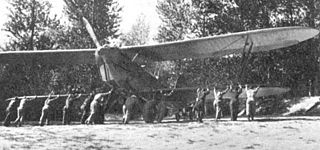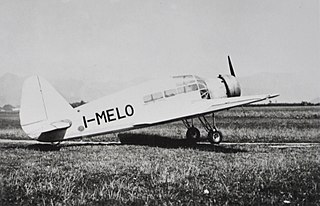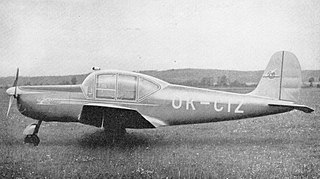
The Fieseler Fi 5 was a single-engined two-seat sportplane of the 1930s. It was produced by the German aircraft manufacturer Fieseler Flugzeugbau, which was started by the World War I fighter ace and German aerobatic star, Gerhard Fieseler.

The Aero A.14 was a Czechoslovakian biplane military reconnaissance aircraft built in the 1920s. It was essentially a slightly modified version of the Hansa-Brandenburg C.I aircraft that Aero had built during World War I as the Ae.10, and for this reason, the aircraft is sometimes referred to as the A.14 Brandenburg. When equipped with a slightly different engine, the aircraft was designated A.15 instead. The two versions were otherwise almost identical.

The Aero A.101 was a biplane light bomber and reconnaissance aircraft built in Czechoslovakia during the 1930s.

The Aero A.300 was a Czechoslovak bomber aircraft that first flew in 1938 as a much refined development of the A.304. It was designed by Aero to meet a requirement for a bomber-reconnaissance aircraft for the Czechoslovak Air Force, the Aero A-304 transport/bomber formed the basis for its design. It was a four-seat aircraft powered by two Bristol Mercury IX radial engines. The A-300 was faster than any other Czechoslovak aircraft in the inventory except for the Avia B-35 fighter. Despite showing much promise, development and production of the aircraft was stopped by the German occupation of Czechoslovakia.

The RWD 9 was a Polish sports plane of 1934, constructed by the RWD team.

PZL.26 was a Polish sports plane built in 1934 by the Państwowe Zakłady Lotnicze. Ordered by the Ministry of Defence, it was specifically designed for the upcoming Challenge 1934 International Touring Aircraft Contest.

The Praga BH-111 was a sportsplane of Czechoslovakia, designed and built specifically to compete in Challenge 1932, the European touring plane championships. It was a two-seater low-wing monoplane.

The Caproni PS.1, also known as the Pallavicino PS-1 and Caproni Ca.303, was an Italian four-seater sportsplane, designed and built specifically to compete in Challenge 1934, the European touring plane championships.

The Fieseler Fi 97 was a 1930s German four-seat cabin touring and competition monoplane aircraft designed and built by the German manufacturer Fieseler.

The Klemm Kl 36 is a 1930s German four-seat cabin touring and competition monoplane. It was designed by Klemm and Friedrich Fechner and built by Klemm.

The Mráz M-3 Bonzo was a light aircraft built in Czechoslovakia in 1948 as a further development in the family of light aircraft that had commenced with the M-1 Sokol.
The Pazmany PL-9 Stork is an American single-engined high-wing monoplane designed by Ladislao Pazmany as a ¾ scale variant of the Second World War Fieseler Storch for the home builder market.

The Bernard H.52 was a French floatplane fighter aircraft of the 1930s. It was a single engine, single-seat monoplane built in the hope of being selected by the French Navy. Two prototypes were built, but no production followed.

The Wassmer WA-30 Bijave is a French two-seat advanced training glider designed and built by Wassmer Aviation of Issoire.

The Cunningham-Hall GA-21 was an American two-seat monoplane design to compete for the Guggenheim Safe Aircraft Competition in 1934. Its distinguishing feature was full span flaps which could be manually or automatically adjusted. The GA-36 was a military version of it with tandem, rather than side-by-side seating.
The IS-3 was the basis of a family of high performance gliders designed by Iosif Șilimon and built in Romania in the 1950s at the URMV-3 factory at Brașov.

The Fieseler F 4 was developed, built and flown as a two-seat sports and travel aircraft at the Fieseler Flugzeugbau.

TheYakovlev AIR-9 / AIR-9bis was a 2-seat sport aircraft designed and built in the USSR during the early 1930s.

The Huntington H-11 Governor was a two-seat cabin monoplane with a high, cantilever wing built in the United States and first flown around 1930. Three were completed.

The Praga E-51 is a Czechoslovakian reconnaissance aircraft and light bomber built by Praga in the 1930s. Development was halted by the annexation of Czechoslovakia by Germany, after only one prototype had been built. The appearance of the construction is very reminiscent of the contemporary twin engined fighter, the Fokker G.I from Holland.



















